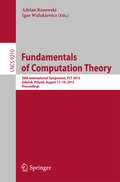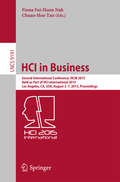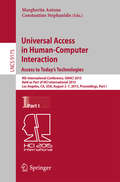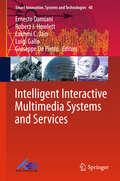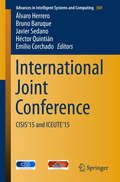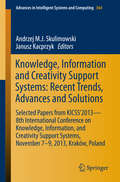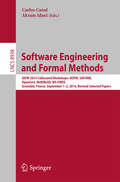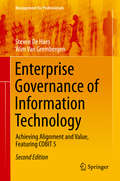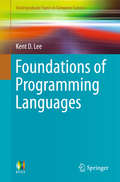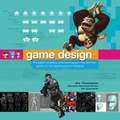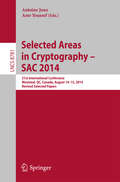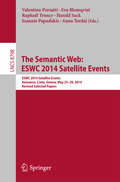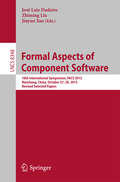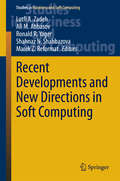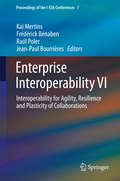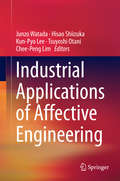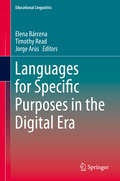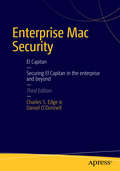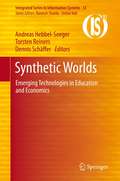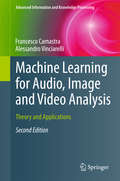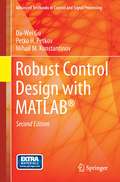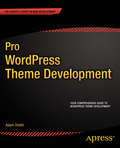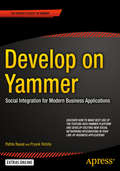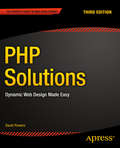- Table View
- List View
Fundamentals of Computation Theory
by Adrian Kosowski Igor WalukiewiczThis book constitutes the refereed proceedings of the 20th International Symposium on Fundamentals of Computation Theory, FCT 2015, held in Gdańsk, Poland, in August 2015. The 27 revised full papers presented were carefully reviewed and selected from 60 submissions. The papers cover topics in three main areas: algorithms, formal methods, and emerging fields and are organized in topical sections on geometry, combinatorics, text algorithms; complexity and Boolean functions; languages; set algorithms, covering, and traversal; graph algorithms and networking applications; anonymity and indistinguishability; graphs, automata, and dynamics; and logic and games.
HCI in Business
by Fiona Fui-Hoon Nah Chuan-Hoo TanThis volume constitutes the refereed proceedings of the Second International Conference on HCI in Business, HCIB 2015, held as part of the 17th International Conference on Human-Computer Interaction, HCII 2015, which took place in Los Angeles, CA, USA, in August 2015. HCII 2015 received a total of 4843 submissions, of which 1462 papers and 246 posters were accepted for publication after a careful reviewing process. The papers address the latest research and development efforts and highlight the human aspects of design and use of computing systems. They thoroughly cover the entire field of human-computer interaction, addressing major advances in knowledge and effective use of computers in a variety of application areas. The 72 papers presented in this volume address the following topics: social media for business, enterprise systems, business and gamification, analytics, visualization and decision- making, industry, academia, innovation, and market.
Universal Access in Human-Computer Interaction. Access to Today's Technologies
by Margherita Antona Constantine StephanidisThe four LNCS volume set 9175-9178 constitutes the refereed proceedings of the 9th International Conference on Learning and Collaboration Technologies, UAHCI 2015, held as part of the 17th International Conference on Human-Computer Interaction, HCII 2015, in Los Angeles, CA, USA in August 2015, jointly with 15 other thematically similar conferences. The total of 1462 papers and 246 posters presented at the HCII 2015 conferences were carefully reviewed and selected from 4843 submissions. These papers of the four volume set address the following major topics: LNCS 9175, Universal Access in Human-Computer Interaction: Access to today's technologies (Part I), addressing the following major topics: LNCS 9175: Design and evaluation methods and tools for universal access, universal access to the web, universal access to mobile interaction, universal access to information, communication and media. LNCS 9176: Gesture-based interaction, touch-based and haptic Interaction, visual and multisensory experience, sign language technologies, and smart and assistive environments LNCS 9177: Universal Access to Education, universal access to health applications and services, games for learning and therapy and cognitive disabilities and cognitive support and LNCS 9178: Universal access to culture, orientation, navigation and driving, accessible security and voting, universal access to the built environment and ergonomics and universal access.
Intelligent Interactive Multimedia Systems and Services
by Lakhmi C. Jain Robert J. Howlett Ernesto Damiani Luigi Gallo Giuseppe De PietroIntelligent interactive multimedia systems and services will be ever more important in computer systems. Nowadays, computers are widespread and computer users range from highly qualified scientists to non-computer expert professionals. Therefore, designing dynamic personalization and adaptivity methods to store, process, transmit and retrieve information is critical for matching the technological progress with the consumer needs. This book contains the contributions presented at the eighth international KES conference on Intelligent Interactive Multimedia: Systems and Services, which took place in Sorrento, Italy, June 17-19, 2015. It contains 33 peer-reviewed scientific contributions that focus on issues ranging from intelligent image or video storage, retrieval, transmission and analysis to knowledge-based technologies, from advanced information technology architectures for video processing and transmission to advanced functionalities of information and knowledge-based services. We believe that this book will serve as a useful source of knowledge for both academia and industry, for all those faculty members, research scientists, scholars, Ph. D. students and practitioners, who are interested in fundamental and applied facets of intelligent interactive multimedia.
International Joint Conference
by Bruno Baruque Álvaro Herrero Javier Sedano Héctor Quintián Emilio CorchadoThis volume of Advances in Intelligent and Soft Computing contains accepted papers presented at the 8th International Conference on Computational Intelligence in Security for Information Systems (CISIS 2015) and the 6th International Conference on European Transnational Education (ICEUTE 2015). These conferences were held in the beautiful and historic city of Burgos (Spain), in June 2015. The aim of the 8th CISIS conference is to offer a meeting opportunity for academic and industry-related researchers belonging to the various, vast communities of Computational Intelligence, Information Security, and Data Mining. The need for intelligent, flexible behaviour by large, complex systems, especially in mission-critical domains, is intended to be the catalyst and the aggregation stimulus for the overall event. After a through peer-review process, the CISIS 2015 International Program Committee selected 43 papers, written by authors from 16 different countries. In the case of 6th ICEUTE conference, the International Program Committee selected 12 papers (from 7 countries). These papers are published in present conference proceedings, achieving an acceptance rate of about 39%. The selection of papers was extremely rigorous in order to maintain the high quality of the conference and we would like to thank the members of the Program Committees for their hard work in the reviewing process. This is a crucial process to the creation of a high standard conference and the CISIS and ICEUTE conferences would not exist without their help.
Knowledge, Information and Creativity Support Systems: Recent Trends, Advances and Solutions
by Janusz Kacprzyk Andrzej M.J. SkulimowskiThis volume contains some carefully selected papers presented at the 8th International Conference on Knowledge, Information and Creativity Support Systems KICCS'2013, which was held in Kraków and Wieliczka, Poland in November 2013. In most cases the papers are extended versions with newer results added, representing virtually all topics covered by the conference. The KICCS'2013 focus theme, "Looking into the Future of Creativity and Decision Support Systems", clearly indicates that the growing complexity calls for some deeper and insightful discussions about the future but, obviously, complemented with an exposition of modern present developments that have proven their power and usefulness. Following this theme, the list of topics presented in this volume include some future-oriented fields of research, such as anticipatory networks and systems, foresight support systems, relevant newly-emerging applications, exemplified by autonomous creative systems. Special attention was also given to cognitive and collaborative aspects of creativity.
Software Engineering and Formal Methods
by Carlos Canal Akram IdaniThis book constitutes revised selected papers from the workshops collocated with the SEFM 2014 conference on Software Engineering and Formal Methods, held in Grenoble, France, in September 2014. The 26 papers included in this volume were carefully reviewed and selected from 49 submissions. They are from the following workshops: the 1st Workshop on Human-Oriented Formal Methods - From Readability to Automation, HOFM 2014, the 3rd International Symposium on Modelling and Knowledge Management Applications - Systems and Domains, MoKMaSD 2014, the 8th International Workshop on Foundations and Techniques for Open Source Software Certification, Open Cert 2014, the 1st Workshop on Safety and Formal Methods, SaFoMe 2014 and the 4th Workshop on Formal Methods in the Development of Software, WS-FMDS 2014.
Enterprise Governance of Information Technology
by Steven Haes Wim GrembergenFeaturing numerous case examples from companies around the world, this second edition integrates theoretical advances and empirical data with practical applications, including in-depth discussion on the COBIT 5 framework which can be used to build, measure and audit enterprise governance of IT approaches. At the forefront of the field, the authors of this volume draw from years of research and advising corporate clients to present a comprehensive resource on enterprise governance of IT (EGIT). Information technology (IT) has become a crucial enabler in the support, sustainability and growth of enterprises. Given this pervasive role of IT, a specific focus on EGIT has arisen over the last two decades, as an integral part of corporate governance. Going well beyond the implementation of a superior IT infrastructure, enterprise governance of IT is about defining and embedding processes and structures throughout the organization that enable boards and business and IT people to execute their responsibilities in support of business/IT alignment and value creation from their IT-enabled investments. Featuring a variety of elements, including executive summaries and sidebars, extensive references and questions and activities (with additional materials available on-line), this book will be an essential resource for professionals, researchers and students alike
Foundations of Programming Languages
by Kent D. LeeThis clearly written textbook introduces the reader to the three styles of programming, examining object-oriented/imperative, functional, and logic programming. The focus of the text moves from highly prescriptive languages to very descriptive languages, demonstrating the many and varied ways in which we can think about programming. Designed for interactive learning both inside and outside of the classroom, each programming paradigm is highlighted through the implementation of a non-trivial programming language, demonstrating when each language may be appropriate for a given problem. Features: includes review questions and solved practice exercises, with supplementary code and support files available from an associated website; provides the foundations for understanding how the syntax of a language is formally defined by a grammar; examines assembly language programming using CoCo; introduces C++, Standard ML, and Prolog; describes the development of a type inference system for the language Small.
Game Design: Principles, Practice, and Techniques - The Ultimate Guide for the Aspiring Game Designer
by Jim Thompson Barnaby Berbank-Green Nic CusworthPractical, complete coverage of game design basics from design process to production This full-color, structured coursebook offers complete coverage of game design basics, focusing on design rather than computer programming. Packed with exercises, assignments, and step-by-step instructions, it starts with an overview of design theory, then progresses to design processes, and concludes with coverage of design production. Jim Thompson, Barnaby Berbank-Green, and Nic Cusworth (London, UK) are computer game designers and lecturers in animation and computer game design.
Selected Areas in Cryptography -- SAC 2014
by Antoine Joux Amr YoussefThis book constitutes the proceedings of the 21st International Conference on Selected Areas in Cryptography, SAC 2014, held in Montreal, QC, Canada, in August 2014. The 22 papers presented in this volume were carefully reviewed and selected from 103 submissions. There are four areas covered at each SAC conference. The three permanent areas are: design and analysis of symmetric key primitives and cryptosystems, including block and stream ciphers, hash function, MAC algorithms, cryptographic permutations, and authenticated encryption schemes; efficient implementations of symmetric and public key algorithms; mathematical and algorithmic aspects of applied cryptology. This year, the fourth area for SAC 2014 is: algorithms for cryptography, cryptanalysis and their complexity analysis.
The Semantic Web: ESWC 2014 Satellite Events
by Raphael Troncy Harald Sack Valentina Presutti Anna Tordai Eva Blomqvist Ioannis PapadakisThis book constitutes the thoroughly refereed post-conference proceedings of the Satellite Events of the 11th International Conference on the Semantic Web, ESWC 2014, held in Anissaras, Crete, Greece, in May 2014. The volume contains 20 poster and 43 demonstration papers, selected from 113 submissions, as well as 12 best workshop papers selected from 60 papers presented at the workshop at ESWC 2014. Best two papers from AI Mashup Challenge are also included. The papers cover various aspects of the Semantic Web.
Formal Aspects of Component Software
by Zhiming Liu José Luiz Fiadeiro Jinyun XueThis book constitutes the revised selected papers of the 10th International Symposium on Formal Aspects of Component Software, FACS 2013, held in Nanchang, China, in October 2013. The 19 full papers and three invited talks presented were carefully reviewed and selected from 51 submissions. The papers are concerned with how formal methods can be used to make component-based development fit for the new architectures of today and the systems that are now pervading the socio-economic worlds.
Recent Developments and New Directions in Soft Computing
by Lotfi A. Zadeh Ronald R. Yager Marek Z. Reformat Ali M. Abbasov Shahnaz N. ShahbazovaThe book reports on the latest advances and challenges of soft computing. It gathers original scientific contributions written by top scientists in the field and covering theories, methods and applications in a number of research areas related to soft-computing, such as decision-making, probabilistic reasoning, image processing, control, neural networks and data analysis.
Enterprise Interoperability VI
by Raúl Poler Kai Mertins Frédérick Bénaben Jean-Paul BourrièresIn 2007 INTEROP-VLab defined Enterprise Interoperability as "the ability of an enterprise system or application to interact with others at a low cost with a flexible approach". Enterprise Interoperability VI brings together a peer reviewed selection of over 40 papers, ranging from academic research through case studies to industrial and administrative experience of interoperability. It shows how, in a scenario of globalised markets, the capacity to cooperate with other firms efficiently becomes essential in order to remain in the market in an economically, socially and environmentally cost-effective manner, and that the most innovative enterprises are beginning to redesign their business model to become interoperable. This goal of interoperability is vital, not only from the perspective of the individual enterprise but also in the new business structures that are now emerging, such as supply chains, virtual enterprises, interconnected organisations or extended enterprises, as well as in mergers and acquisitions. Establishing efficient and relevant collaborative situations requires managing interoperability from a dynamic perspective: a relevant and efficient collaboration of organizations might require adaptation to remain in line with potentially changing objectives, evolving resources, and unexpected events, for example. Many of the papers contained in this, the seventh volume of Proceedings of the I-ESA Conferences have examples and illustrations calculated to deepen understanding and generate new ideas. The I-ESA'14 Conference is jointly organised by Ecole des Mines Albi-Carmaux, on behalf of PGSO, and the European Virtual Laboratory for Enterprise Interoperability (INTEROP-VLab) and supported by the International Federation for Information Processing (IFIP). A concise reference to the state of the art in systems interoperability, Enterprise Interoperability VI will be of great value to engineers and computer scientists working in manufacturing and other process industries and to software engineers and electronic and manufacturing engineers working in the academic environment.
Industrial Applications of Affective Engineering
by Junzo Watada Hisao Shiizuka Kun-Pyo Lee Tsuyoshi Otani Chee-Peng LimIndustrial Applications of Affective Engineering introduces new analytical methods such as fluctuation, fuzzy logic, fractals, and complex systems, and pursuing interdisciplinary research that traverses a wide range of fields, including information engineering, human engineering, cognitive science, psychology, and design studies. The book is split into two parts: theory and applications. The book is a collection of the best papers from ISAE2013 (International Symposium of Affective Engineering) held at Kitakyushu, Japan and Japan Kansei Engineering Meeting on March 6-8, 2013.
Languages for Specific Purposes in the Digital Era
by Elena Bárcena Timothy Read Jorge ArúsExplores the direct relation of modern CALL (Computer-Assisted Language Learning) to aspects of natural language processing for theoretical and practical applications, and worldwide demand for formal language education and training that focuses on restricted or specialized professional domains. Unique in its broad-based, state-of-the-art, coverage of current knowledge and research in the interrelated fields of computer-based learning and teaching and processing of specialized linguistic domains. The articles in this book offer insights on or analyses of the current state and future directions of many recent key concepts regarding the application of computers to natural languages, such as: authenticity, personalization, normalization, evaluation. Other articles present fundamental research on major techniques, strategies and methodologies that are currently the focus of international language research projects, both of a theoretical and an applied nature.
Big data's big potential in developing economies: impact on agriculture, health and environmental security
by Nir KshetriBig data involves the use of sophisticated analytics to make decisions based on large-scale data inputs. It is set to transform agriculture, environmental protection and healthcare in developing countries. This book critically evaluates the developing big data industry and market in these countries and gives an overview of the determinants, performances and impacts. The book provides a detailed analysis of technology creation, technology infrastructures and human skills to utilize big data in these countries. It discusses novel applications and business models involving big data to overcome healthcare barriers. The book also offers an analysis of big data's potential to improve environmental monitoring and protection. It posits that big data is likely to have far-reaching and profound impacts on the agricultural sector. A key question addressed is also how gains in agricultural productivity associated with big data will benefit smallholder farmers relative to global multinationals in that sector. It also probes big data's roles in the creation of markets that can improve the welfare of smallholder farmers. The book gives special consideration to big data-led transformation of the financial industry and discusses how the transformation can increase small-holder farmers' access to finance by changing the way lenders assess creditworthiness of potential borrowers. It also takes a look at data privacy and security issues facing smallholder farmers and reviews differences in such issues in industrialized and developing countries. The key ideas, concepts and theories presented are explored, illustrated and contrasted through in-depth case studies of developing world-based big data companies and deployment and utilization big data in agriculture, environmental protection and healthcare.
Enterprise Mac Security
by Charles Edge Daniel O'DonnellA common misconception in the Mac community is that Mac's operating system is more secure than others. While this might be have been true in certain cases, security on the Mac has always still been a crucial issue. With the release of OS X 10. 11, the operating system is taking large strides in getting even more secure. Even still, when sharing is enabled or remote control applications are installed, Mac OS X faces a variety of security threats, whether these have been exploited or not. Enterprise Mac Security is a definitive, expert-driven update of the popular, slash-dotted edition which was written in part as a companion to the SANS Institute course for Mac OS X. It contains detailed Mac OS X security information, and walkthroughs on securing systems, including the new 10. 11 operating system. This book caters to both the beginning home user and the seasoned security professional not accustomed to the Mac, establishing best practices for Mac OS X for a wide audience. The authors of this book are seasoned Mac and security professionals, having built many of the largest network infrastructures for Apple and spoken at both DEFCON and Black Hat on OS X security. What you'll learn The newest security techniques on Mac OS X from the best and brightest Security details of Mac OS X for the desktop and server, and how to secure these systems Considerations for third-party applications on systems The details of Mac forensics and Mac hacking How to tackle Apple wireless security Who this book is for This book is for new users, switchers, power users, and administrators that need to make sure their Mac systems are secure. Table of Contents Part I: The Big Picture 1. Security Quick-Start 2. Services, Daemons, and Processes 3. Securing User Accounts 4. File System Permissions 5. Reviewing Logs and Monitoring Part II: Securing the Ecosystem 6. Application Signing and Sandbox 7. Securing Web Browsers and E-mail 8. Malware Security: Combating Viruses, Worms, and Root Kits 9. Encrypting Files and Volumes Part III: Securing the Network 10. Securing Network Traffic 11. Setting Up the Mac OS X Firewall 12. Securing a Wireless Network Part IV: Securely Sharing Resources 13. File Services 14. Web Site Security 15. Remote Connectivity 16. Server Security Part V: Securing the Workplace 17. Network Scanning, Intrusion Detection, and Intrusion Prevention Tools 18. Backup and Fault Tolerance 19. Appendix A 20. Appendix B 21. Appendix
Synthetic Worlds: Emerging Technologies in Education and Economics
by Torsten Reiners Andreas Hebbel-Seeger Dennis SchäfferSynthetic Worlds, Virtual Worlds, and Alternate Realities are all terms used to describe the phenomenon of computer-based, simulated environments in which users inhabit and interact via avatars. The best-known commercial applications are in the form of electronic gaming, and particularly in massively-multiplayer online role-playing games like World of Warcraft or Second Life. Less known, but possibly more important, is the rapid adoption of platforms in education and business, where Serious Games are being used for training purposes, and even Second Life is being used in many situations that formerly required travel. Linden Lab, creator of Second Life, recently announced the creation of Second Life Enterprise, with customers including IBM, Northrop Grumman, and the US Naval Undersea Warfare Center. The editors of this book captures the state of research in the field intended to reflect the rapidly growing yet relatively young market in education and business. The general focus is set on the scientific community but integrates the practical applications for businesses, with papers on information systems, business models, and economics. In six parts, international authors - all experts in their field - discuss the current state-of-the-art of virtual worlds/alternate realities and how the field will develop over the next years. Chapters discuss the influences and impacts in and around virtual worlds. Part four is about education, with a focus on learning environments and experiences, pedagogical models, and the effects on the different roles in the educational sector. The book looks at business models and how companies can participate in virtual worlds while receiving a return on investment, and includes cases and scenarios of integration, from design, implementation to application.
Machine Learning for Audio, Image and Video Analysis
by Alessandro Vinciarelli Francesco CamastraThis second edition focuses on audio, image and video data, the three main types of input that machines deal with when interacting with the real world. A set of appendices provides the reader with self-contained introductions to the mathematical background necessary to read the book. Divided into three main parts, From Perception to Computation introduces methodologies aimed at representing the data in forms suitable for computer processing, especially when it comes to audio and images. Whilst the second part, Machine Learning includes an extensive overview of statistical techniques aimed at addressing three main problems, namely classification (automatically assigning a data sample to one of the classes belonging to a predefined set), clustering (automatically grouping data samples according to the similarity of their properties) and sequence analysis (automatically mapping a sequence of observations into a sequence of human-understandable symbols). The third part Applications shows how the abstract problems defined in the second part underlie technologies capable to perform complex tasks such as the recognition of hand gestures or the transcription of handwritten data. Machine Learning for Audio, Image and Video Analysis is suitable for students to acquire a solid background in machine learning as well as for practitioners to deepen their knowledge of the state-of-the-art. All application chapters are based on publicly available data and free software packages, thus allowing readers to replicate the experiments.
Robust Control Design with MATLAB®
by Da-Wei Gu Mihail M Konstantinov Petko H. PetkovRobust Control Design with MATLAB® (second edition) helps the student to learn how to use well-developed advanced robust control design methods in practical cases. To this end, several realistic control design examples from teaching-laboratory experiments, such as a two-wheeled, self-balancing robot, to complex systems like a flexible-link manipulator are given detailed presentation. All of these exercises are conducted using MATLAB® Robust Control Toolbox 3, Control System Toolbox and Simulink®. By sharing their experiences in industrial cases with minimum recourse to complicated theories and formulae, the authors convey essential ideas and useful insights into robust industrial control systems design using major H-infinity optimization and related methods allowing readers quickly to move on with their own challenges. The hands-on tutorial style of this text rests on an abundance of examples and features for the second edition: * rewritten and simplified presentation of theoretical and methodological material including original coverage of linear matrix inequalities; * new Part II forming a tutorial on Robust Control Toolbox 3; * fresh design problems including the control of a two-rotor dynamic system; and * end-of-chapter exercises. Electronic supplements to the written text that can be downloaded from extras.springer.com/isbn include: * M-files developed with MATLAB® help in understanding the essence of robust control system design portrayed in text-based examples; * MDL-files for simulation of open- and closed-loop systems in Simulink®; and * a solutions manual available free of charge to those adopting Robust Control Design with MATLAB® as a textbook for courses. Robust Control Design with MATLAB® is for graduate students and practising engineers who want to learn how to deal with robust control design problems without spending a lot of time in researching complex theoretical developments.
Pro WordPress Theme Development
by Adam OnishiPro WordPress Theme Development is your comprehensive guide to creating advanced WordPress themes. Designed for for professional web designers and developers who are comfortable with PHP and WordPress, this book teaches you every aspect of professional theme development. You will learn how to build themes from scratch, how to monetize the themes you create, and how to capitalize on this by creating advanced themes for your clients or selling premium themes. This book builds on your current knowledge of PHP and web development to create a WordPress theme from scratch. It uses a real-world theme example that you can build, to demonstrate each feature in a practical way. It shows you how to take control of WordPress with custom posts types and taxonomies, and covers anatomy and hierarchy, use of the loop, hooks, short codes, plug-ins and much more. WordPress is one of the most successful open-source blogging and content management systems available, and theme development has become a major part of the WordPress ecosystem. Start working with WordPress themes like a pro today with Pro WordPress Theme Development. What you'll learn How to create a WordPress theme from scratch How to use the WordPress system to your advantage to create amazing advanced functionality How to earn money through selling your custom themes How to take control of WordPress as a content management system with custom posts types and taxonomies How you should secure your WordPress theme to give peace of mind to your user Who this book is for Pro WordPress Theme Development is for web designers and developers who want to start creating their own themes and get the most out of them. This book is for web professionals who are familiar with PHP and WordPress, and have used both before, but want to go from editing themes to creating their own custom themes. Pro WordPress Theme Development is perfect for developers who want to create themes from scratch with advanced features, capitalize on the large WordPress community, and monetize their new found skills. Table of Contents Getting Started Theme Anatomy and Template Hierarchy Content Options and The Loop Using Custom Post Types Creating Custom Taxonomies and Fields Customize with Hooks and Short Codes Theme Options Users, Roles, and Permissions Plugins - When The Time is Right Security and Performance Distributing Your WordPress Theme Extending your WordPress Theme Plugin Development WordPress Multisite
Develop on Yammer
by Pathik Rawal Pryank RohillaDevelop on Yammer is your guide to integrating the Yammer social network with your company's application ecosystem. By developing custom apps and features on the Yammer platform, you can make your workplace more productive, encourage communication and feedback, and get your colleagues collaborating across a range of platforms, including SharePoint, ASP. NET, and Windows Phone. The book begins with an introduction to the development options available along with guidance on how to set up a Yammer developer account. You'll then take your first step in Yammer integration by building a Yammer feed into a web page or other JavaScript-based client application, before diving into app creation and management on the Yammer platform. The authors provide a deep dive into the Yammer authorization process from client-side and server-side perspectives, and you'll find out how to work closely with Yammer's data streams and its full range of development possibilities using Open Graph and Yammer's REST API. The final chapters cover how to build Yammer integration into standalone applications for SharePoint and Windows Phone 8 with Yammer SDKs. All chapters are illustrated with examples and sample code, and a case study follows the development of a workplace training application as the authors apply each technique, so you can see how to make the most of what Yammer has to offer. What you'll learn Why develop on Yammer, and what development options are available How to add a Yammer feed to an HTML-based application using Yammer Embed, to bring relevant news and discussions into the contexts where they matter How to develop custom Yammer features for your SharePoint, Office or web applications on the client side with the Yammer JavaScript SDK How to carry out secure authorization and authentication on Yammer How to use Yammer Open Graph and REST APIs to posts messages, create custom activities and get data from Yammer-integrated applications How to work with the Yammer Windows Phone 8 SDK to add Yammer functionality to a Windows Phone 8 application Who this book is for This book is targeted at developers with a background in . NET/C# development. Readers should be comfortable working with JavaScript. Software architects will also find this book valuable for planning social integration across their companies' business ecosystems. Table of Contents Chapter 1: Introduction to Yammer Development Chapter 2: Yammer Feed Integration with Yammer Embed Chapter 3: Yammer App Development Basics Chapter 4: Authenticating Your Yammer Users Chapter 5: Writing Data into Yammer with Open Graph Chapter 6: Developing Custom Integrations with the Yammer REST API Chapter 7: Build Social Apps Using Yammer's JavaScript SDK Chapter 8: Build Social Apps Using Yammer's Windows Phone 8 SDK
PHP Solutions
by David PowersThis is the third edition of David Powers' highly-respected PHP Solutions: Dynamic Web Design Made Easy. This new edition has been updated by David to incorporate changes to PHP since the second edition and to offer the latest techniques--a classic guide modernized for 21st century PHP techniques, innovations, and best practices. You want to make your websites more dynamic by adding a feedback form, creating a private area where members can upload images that are automatically resized, or perhaps storing all your content in a database. The problem is, you're not a programmer and the thought of writing code sends a chill up your spine. Or maybe you've dabbled a bit in PHP and MySQL, but you can't get past baby steps. If this describes you, then you've just found the right book. PHP and the MySQL database are deservedly the most popular combination for creating dynamic websites. They're free, easy to use, and provided by many web hosting companies in their standard packages. Unfortunately, most PHP books either expect you to be an expert already or force you to go through endless exercises of little practical value. In contrast, this book gives you real value right away through a series of practical examples that you can incorporate directly into your sites, optimizing performance and adding functionality such as file uploading, email feedback forms, image galleries, content management systems, and much more. Each solution is created with not only functionality in mind, but also visual design. But this book doesn't just provide a collection of ready-made scripts: each PHP Solution builds on what's gone before, teaching you the basics of PHP and database design quickly and painlessly. By the end of the book, you'll have the confidence to start writing your own scripts or--if you prefer to leave that task to others--to adapt existing scripts to your own requirements. Right from the start, you're shown how easy it is to protect your sites by adopting secure coding practices.
